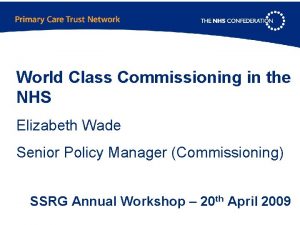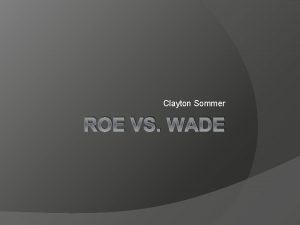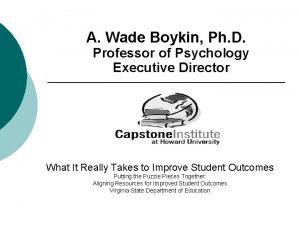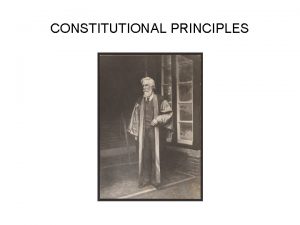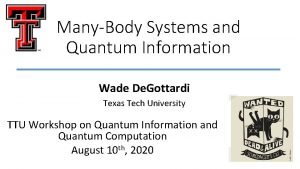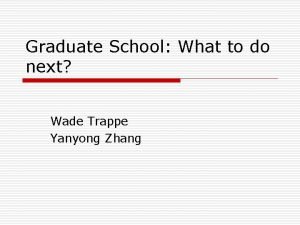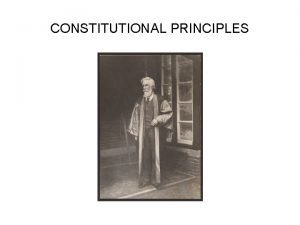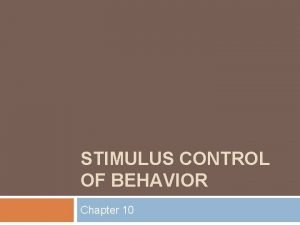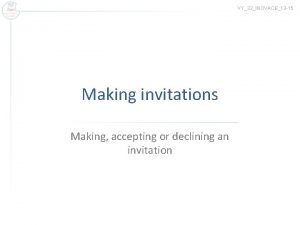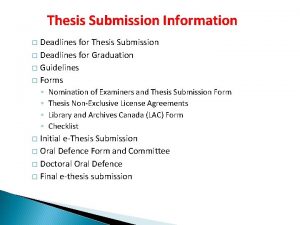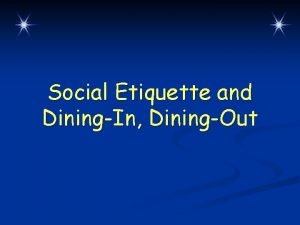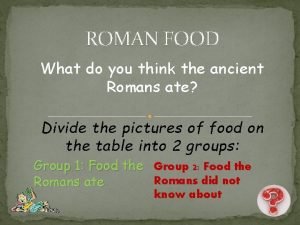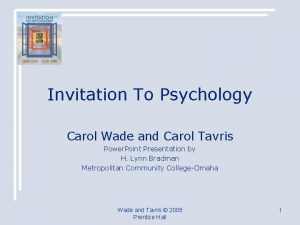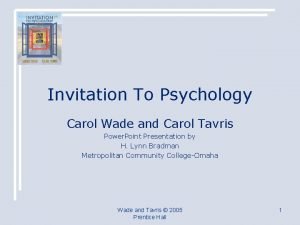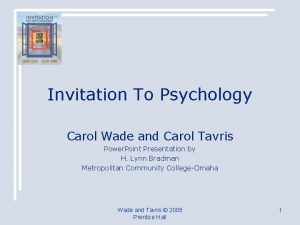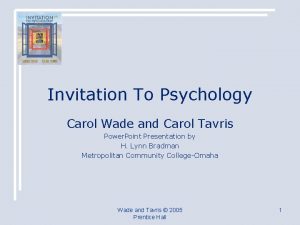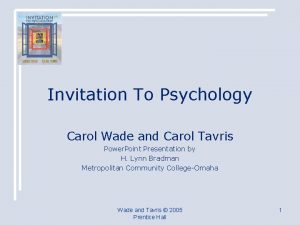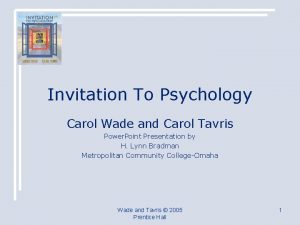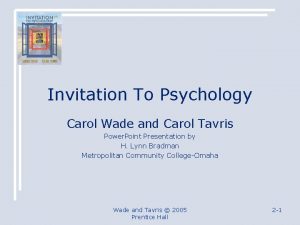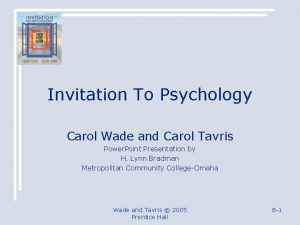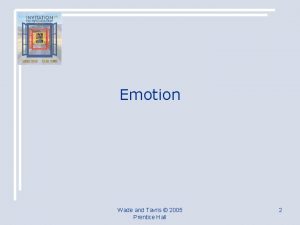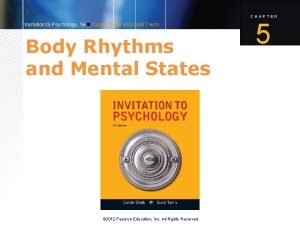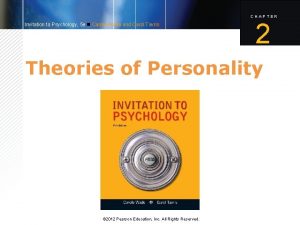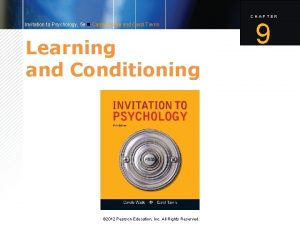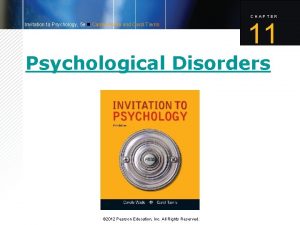Invitation To Psychology Carol Wade and Carol Tavris






































- Slides: 38

Invitation To Psychology Carol Wade and Carol Tavris Power. Point Presentation by H. Lynn Bradman Metropolitan Community College-Omaha Wade and Tavris © 2005 Prentice Hall 1

Thinking and Intelligence Wade and Tavris © 2005 Prentice Hall 2

Thinking and Intelligence • • • Thought: Using What We Know Reasoning Rationally Barriers to Reasoning Rationally Intelligence The Origins of Intelligence Animal Minds Wade and Tavris © 2005 Prentice Hall 3

Thought: Using What We Know The Elements of Cognition How Conscious Is Thought? Wade and Tavris © 2005 Prentice Hall 4

The Elements of Cognition • Concept: Mental category that groups objects, relations, activities, abstractions, or qualities having common properties. • Proposition: A unit of meaning that is made up of concepts and expresses a single idea. • Mental Image: Representation that mirrors or resembles the thing it represents. • Cognitive Schema: An integrated mental network of knowledge, beliefs, and expectations concerning a particular topic or aspect of the world. Wade and Tavris © 2005 Prentice Hall 5

How Conscious is Thought? • Subconscious Processes: Mental processes occurring outside of conscious awareness but accessible to consciousness when necessary. • Nonconscious Processes: Mental processes occurring outside of and not available to conscious awareness. Wade and Tavris © 2005 Prentice Hall 6

Reasoning Rationally Wade and Tavris © 2005 Prentice Hall 7

Reasoning Rationally • Formal Reasoning: Algorithms and Logic • Informal Reasoning: Heuristics and Dialectical Thinking • Reflective Judgment Wade and Tavris © 2005 Prentice Hall 8

Formal Logic • Deductive Reasoning: A tool of formal logic in which a conclusion necessarily follows from a set of observations or propositions (premises). Wade and Tavris © 2005 Prentice Hall 9

Formal Logic • Inductive Reasoning: A tool of formal logic in which a conclusion probably follows from a set of observations or propositions or premises, but could be false. Wade and Tavris © 2005 Prentice Hall 10

Informal Reasoning • Heuristic: – A rule of thumb that suggests a course of action or guides problem solving but does not guarantee an optimal solution. • Dialectical Reasoning: – A process in which opposing facts or ideas are weighed and compared, with a view to determining the best solution or resolving differences. Wade and Tavris © 2005 Prentice Hall 11

Barriers to Reasoning Rationally Wade and Tavris © 2005 Prentice Hall 12

Barriers to Reasoning Rationally • • Exaggerating the Improbable Avoiding Loss The Confirmation Biases Due to Mental Sets The Hindsight Bias The Need for Cognitive Consistency Overcoming Our Cognitive Biases Wade and Tavris © 2005 Prentice Hall 13

Exaggerating the Improbable • Availability Heuristic: – The tendency to judge the probability of an event by how easy it is to think of examples or instances. – For example, most people overestimate the odds of dying in a plane crash. – Dying in an automobile accident is far more likely. Wade and Tavris © 2005 Prentice Hall 14

Avoiding Loss • People try to minimize risks and losses when making decisions. • Responses to the same choice will differ based on whether outcome is framed as gain or loss. – In the example, outcomes are the same in Problems 1 and 2. Wade and Tavris © 2005 Prentice Hall 15

The Confirmation Bias • Confirmation Bias: The tendency to look for or pay attention only to information that confirms one’s own beliefs. E J 6 7 Test this rule: If a card has a vowel on one side, it has an even number on the other side. Which 2 cards to turn over? Wade and Tavris © 2005 Prentice Hall 16

Biases Due to Mental Sets • Mental Set: A tendency to solve problems using procedures that worked before on similar problems. • Mental sets help us solve most problems efficiently. • Not helpful when a problem calls for fresh insights or a new approach. Wade and Tavris © 2005 Prentice Hall 17

The Nine-Dot Problem • Connect all 9 dots • Use only 4 lines • Do not lift your pencil from the page after you begin drawing Wade and Tavris © 2005 Prentice Hall 18

The Hindsight Bias • Hindsight Bias: The tendency to overestimate one’s ability to have predicted an event once the outcome is known. – Also known as the “I knew it all along” phenomenon. • “The older they get the better they were when they were younger. ” – Jim Bouton, professional baseball player Wade and Tavris © 2005 Prentice Hall 19

Need for Cognitive Consistency • Cognitive Dissonance: – A state of tension that occurs when a person simultaneously holds two cognitions that are psychologically inconsistent, or when a person’s belief is inconsistent with his or her behavior. Wade and Tavris © 2005 Prentice Hall 20

Intelligence Wade and Tavris © 2005 Prentice Hall 21

Intelligence • Measuring Intelligence: The Psychometric Approach • Dissecting Intelligence: The Cognitive Approach Wade and Tavris © 2005 Prentice Hall 22

Intelligence • Intelligence: An inferred characteristic of an individual, usually defined as the ability to profit from experience, acquire knowledge, think abstractly, act purposefully, or adapt to changes in the environment. • g factor: A general intellectual ability assumed by many theorists to underlie specific mental abilities and talents. Wade and Tavris © 2005 Prentice Hall 23

The Psychometric Approach • IQ scores are distributed “normally” – Bell-shaped curve • Very high and low scores are rare – 68% of people have IQ between 85 -115 – 99. 7% between 55145 Wade and Tavris © 2005 Prentice Hall 24

The Cognitive Approach • Metacognition: The knowledge or awareness of one’s own cognitive processes. • Tacit Knowledge: Strategies for success that are not explicitly taught but that instead must be inferred. Wade and Tavris © 2005 Prentice Hall 25

Sternberg's Triarchic Theory • Components - a. k. a. “Analytic” – Comparing, analyzing, and evaluating. – This type of processes correlates best with IQ. • Experiential - a. k. a. “Creative” – Inventing or designing solutions to new problems. – Transfer skills to new situations. • Contextual - a. k. a. “Practical” – Using (i. e. , applying) the things you know in everyday contexts. Wade and Tavris © 2005 Prentice Hall 26

The Origins of Intelligence Wade and Tavris © 2005 Prentice Hall 27

The Origins of Intelligence • Genes and Intelligence • The Environment and Intelligence • Attitudes, Motivation, and Intellectual Success Wade and Tavris © 2005 Prentice Hall 28

Correlations in Siblings’ IQ Scores • IQ scores of siblings were highly correlated, even when they were reared apart. • Identical twins have higher correlations than fraternal twins. – Suggests a genetic link Wade and Tavris © 2005 Prentice Hall 29

Explaining Group Differences • Within a group with all treated exactly the same, differences may reflect genetics. • When one group differs from another, the differences may reflect environmental differences. Wade and Tavris © 2005 Prentice Hall 30

Environment and Intelligence • Factors associated with reduced IQ: – Poor prenatal care – Malnutrition – Exposure to toxins – Stressful family circumstances • Healthy and stimulating environments can raise IQ, sometimes dramatically. Wade and Tavris © 2005 Prentice Hall 31

Wade and Tavris © 2005 Prentice Hall 32

Attitudes and Intellectual Success • Asian children score higher on standard math tests than American children. • Differences: – Americans are more likely than Asians to believe that math ability is innate. – Americans have far lower standards for their children. – Asian children value education more highly than Americans. Wade and Tavris © 2005 Prentice Hall 33

Animal Minds Wade and Tavris © 2005 Prentice Hall 34

Animal Minds • Animal Intelligence • Animals and Language • Thinking About the Thinking of Animals Wade and Tavris © 2005 Prentice Hall 35

Animal Intelligence • Cognitive Ethology: The study of cognitive processes in nonhuman animals. • Studies in cognitive ethology have shown evidence that some animals can – Anticipate future events – Use numbers to label quantities – Coordinate activities with other animals Wade and Tavris © 2005 Prentice Hall 36

Animals and Language • Language is a critical element of human cognition • Many animal species can be taught to communicate in ways that resemble language – Chimpanzees and bonobos converse using American Sign Language and symbol board systems – An African grey parrot has been taught to count, classify, and compare objects using English words • Whether these behaviors are language depends on how you define “language. ” Wade and Tavris © 2005 Prentice Hall 37

Thinking About Animal Thinking • Anthropomorphism: The tendency to falsely attribute human qualities to nonhuman beings. • Anthropocentrism: The tendency to think, mistakenly, that human beings have nothing in common with other animals. Wade and Tavris © 2005 Prentice Hall 38
 Elizabeth wade nhs
Elizabeth wade nhs Kris kappel
Kris kappel Thomas wade evans
Thomas wade evans The roe wade
The roe wade Organic chemistry wade
Organic chemistry wade Roe vs wade background
Roe vs wade background Wade boykin
Wade boykin Reach throw wade row swim tow
Reach throw wade row swim tow Sir william wade
Sir william wade Wade lipscomb
Wade lipscomb Felicia wade
Felicia wade Creighton disability services
Creighton disability services Wade degottardi
Wade degottardi Wade trappe
Wade trappe Sir william wade
Sir william wade Wade alexander phipps
Wade alexander phipps Anoraks almanac
Anoraks almanac Wade shafer
Wade shafer Roe v wade summary
Roe v wade summary Wade henning
Wade henning Lashley wade theory
Lashley wade theory Roe v wade summary
Roe v wade summary Professor derick wade
Professor derick wade The formal reply is written in
The formal reply is written in Dialogue about invitation birthday party
Dialogue about invitation birthday party Positive psychology ap psychology definition
Positive psychology ap psychology definition Social facilitation psychology
Social facilitation psychology Social psychology ap psychology
Social psychology ap psychology Scope of psychology
Scope of psychology Social psychology is the scientific study of:
Social psychology is the scientific study of: Health psychology definition ap psychology
Health psychology definition ap psychology Thesis defense introduction script
Thesis defense introduction script Invitation to treat
Invitation to treat Takmeel e quran invitation
Takmeel e quran invitation Dave engels
Dave engels Hurrah for the fourth of july cartoon
Hurrah for the fourth of july cartoon It is polite to rsvp to an invitation within ______ day(s).
It is polite to rsvp to an invitation within ______ day(s). Ancient roman dinner party invitation
Ancient roman dinner party invitation Ny state of health assistor certification training
Ny state of health assistor certification training
